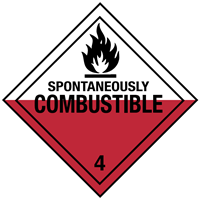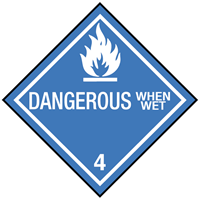Chemical Datasheet
TRIISOBUTYL ALUMINUM |


|
Chemical Identifiers
The
Chemical Identifier fields
include common identification numbers, the
NFPA diamond
U.S. Department of Transportation hazard labels, and a general
description of the chemical. The information in CAMEO Chemicals comes
from a variety of
data sources.
| CAS Number | UN/NA Number | DOT Hazard Label | USCG CHRIS Code |
|---|---|---|---|
|
|
||
| NIOSH Pocket Guide | International Chem Safety Card | ||
| none | none | ||
NFPA 704
| Diamond | Hazard | Value | Description | |||||||||
|---|---|---|---|---|---|---|---|---|---|---|---|---|
|
|
3 | Can cause serious or permanent injury. | |||||||||
|
|
4 | Burns readily. Rapidly or completely vaporizes at atmospheric pressure and normal ambient temperature. | ||||||||||
|
|
3 | Capable of detonation or explosive decomposition or explosive reaction but requires a strong initiating source or must be heated under confinement before initiation. | ||||||||||
|
|
| Reacts violently or explosively with water. |
|
(NFPA, 2010)
General Description
A colorless liquid.
Hazards
The
Hazard fields
include
special hazard alerts
air and water
reactions, fire hazards, health hazards, a reactivity profile, and
details about
reactive groups assignments
and
potentially incompatible absorbents.
The information in CAMEO Chemicals comes from a variety of
data sources.
Reactivity Alerts
- Strong Reducing Agent
- Water-Reactive
- Pyrophoric
Air & Water Reactions
Pyrophoric. Reacts violently with water producing flammable gas [Rose 1961].
Fire Hazard
Special Hazards of Combustion Products: Dense smoke may cause metal-fume fever.
Behavior in Fire: Dense smoke of aluminum oxide forms. (USCG, 1999)
Behavior in Fire: Dense smoke of aluminum oxide forms. (USCG, 1999)
Health Hazard
Inhalation of smoke from fire causes metal-fume fever (flu-like symptoms). Contact with liquid can cause severe burns of eyes and skin because of spontaneous ignition. (USCG, 1999)
Reactivity Profile
TRIISOBUTYL ALUMINUM reacts violently with alcohols, phenols, amines, carbon dioxide, sulfur oxides, nitrogen oxides, halogens, and halogenated hydrocarbons, causing fire and explosion hazards [Handling Chemicals Safely 1980. p. 937].
Belongs to the Following Reactive Group(s)
Potentially Incompatible Absorbents
No information available.
Response Recommendations
The
Response Recommendation fields
include isolation and evacuation distances, as well as recommendations for
firefighting, non-fire response, protective clothing, and first aid. The
information in CAMEO Chemicals comes from a variety of
data sources.
Isolation and Evacuation
Excerpt from ERG Guide 135 [Substances - Spontaneously Combustible]:
IMMEDIATE PRECAUTIONARY MEASURE: Isolate spill or leak area in all directions for at least 50 meters (150 feet) for liquids and at least 25 meters (75 feet) for solids.
SPILL: Increase the immediate precautionary measure distance, in the downwind direction, as necessary.
FIRE: If tank, rail tank car or highway tank is involved in a fire, ISOLATE for 800 meters (1/2 mile) in all directions; also, consider initial evacuation for 800 meters (1/2 mile) in all directions. (ERG, 2024)
IMMEDIATE PRECAUTIONARY MEASURE: Isolate spill or leak area in all directions for at least 50 meters (150 feet) for liquids and at least 25 meters (75 feet) for solids.
SPILL: Increase the immediate precautionary measure distance, in the downwind direction, as necessary.
FIRE: If tank, rail tank car or highway tank is involved in a fire, ISOLATE for 800 meters (1/2 mile) in all directions; also, consider initial evacuation for 800 meters (1/2 mile) in all directions. (ERG, 2024)
Firefighting
Fire Extinguishing Agents Not to Be Used: Water, foam, halogenated extinguishing agents
Fire Extinguishing Agents: Inert powder (e.g., sand, limestone), dry chemical (USCG, 1999)
Fire Extinguishing Agents: Inert powder (e.g., sand, limestone), dry chemical (USCG, 1999)
Non-Fire Response
Excerpt from ERG Guide 135 [Substances - Spontaneously Combustible]:
ELIMINATE all ignition sources (no smoking, flares, sparks or flames) from immediate area. Do not touch or walk through spilled material. Stop leak if you can do it without risk.
SMALL SPILL: CAUTION: For spills of Xanthates, UN3342 and for Dithionite (Hydrosulfite/Hydrosulphite), UN1384, UN1923 and UN1929, dissolve in 5 parts water and collect for proper disposal. CAUTION: UN3342 when flooded with water will continue to evolve flammable Carbon disulfide/Carbon disulphide vapors. Cover with DRY earth, DRY sand or other non-combustible material followed with plastic sheet to minimize spreading or contact with rain. Use clean, non-sparking tools to collect material and place it into loosely covered plastic containers for later disposal. Prevent entry into waterways, sewers, basements or confined areas. (ERG, 2024)
ELIMINATE all ignition sources (no smoking, flares, sparks or flames) from immediate area. Do not touch or walk through spilled material. Stop leak if you can do it without risk.
SMALL SPILL: CAUTION: For spills of Xanthates, UN3342 and for Dithionite (Hydrosulfite/Hydrosulphite), UN1384, UN1923 and UN1929, dissolve in 5 parts water and collect for proper disposal. CAUTION: UN3342 when flooded with water will continue to evolve flammable Carbon disulfide/Carbon disulphide vapors. Cover with DRY earth, DRY sand or other non-combustible material followed with plastic sheet to minimize spreading or contact with rain. Use clean, non-sparking tools to collect material and place it into loosely covered plastic containers for later disposal. Prevent entry into waterways, sewers, basements or confined areas. (ERG, 2024)
Protective Clothing
Full protective clothing, preferably of aluminized glass cloth; goggles; face shield; gloves. In case of fire, all-purpose canister or self-contained breathing apparatus. (USCG, 1999)
DuPont Tychem® Suit Fabrics
No information available.
First Aid
INHALATION: only fumes from fire need be considered; metal-fume fever lasts less than 36 hrs. and is not critical.
EYES: flush gently with copious quantities of water for 15 min. with lids open; treat burns, if fire occurred; get medical attention.
SKIN: wash with water; treat burns caused by fire; get medical attention.
INGESTION: (USCG, 1999)
EYES: flush gently with copious quantities of water for 15 min. with lids open; treat burns, if fire occurred; get medical attention.
SKIN: wash with water; treat burns caused by fire; get medical attention.
INGESTION: (USCG, 1999)
Physical Properties
The
Physical Property fields
include properties such as vapor pressure and
boiling point, as well as explosive limits and
toxic exposure thresholds
The information in CAMEO Chemicals comes from a variety of
data sources.
Note: For Vapor Density and Specific Gravity, comparing the value to 1.0 can tell you if the chemical will likely sink/rise in air or sink/float in fresh water (respectively). Short phrases have been added to those values below as an aid. However, make sure to also consider the circumstances of a release. The Vapor Density comparisons are only valid when the gas escaping is at the same temperature as the surrounding air itself. If the chemical is escaping from a container where it was pressurized or refrigerated, it may first escape and behave as a heavy gas and sink in the air (even if it has a Vapor Density value less than 1). Also, the Specific Gravity comparisons are for fresh water (density 1.0 g/mL). If your spill is in salt water (density about 1.027 g/mL), you need to adjust the point of comparison. There are some chemicals that will sink in fresh water and float in salt water.
Note: For Vapor Density and Specific Gravity, comparing the value to 1.0 can tell you if the chemical will likely sink/rise in air or sink/float in fresh water (respectively). Short phrases have been added to those values below as an aid. However, make sure to also consider the circumstances of a release. The Vapor Density comparisons are only valid when the gas escaping is at the same temperature as the surrounding air itself. If the chemical is escaping from a container where it was pressurized or refrigerated, it may first escape and behave as a heavy gas and sink in the air (even if it has a Vapor Density value less than 1). Also, the Specific Gravity comparisons are for fresh water (density 1.0 g/mL). If your spill is in salt water (density about 1.027 g/mL), you need to adjust the point of comparison. There are some chemicals that will sink in fresh water and float in salt water.
| Chemical Formula: |
|
Flash Point: data unavailable
Lower Explosive Limit (LEL): data unavailable
Upper Explosive Limit (UEL): data unavailable
Autoignition Temperature:
Ignites spontaneously under ambient conditions
(USCG, 1999)
Melting Point:
33.8°F
(USCG, 1999)
Vapor Pressure: data unavailable
Vapor Density (Relative to Air): data unavailable
Specific Gravity:
0.788
at 68°F
(USCG, 1999)
- Less dense than water; will float
Boiling Point:
414°F
at 760 mmHg
(USCG, 1999)
Molecular Weight:
198.3
(USCG, 1999)
Water Solubility: data unavailable
Ionization Energy/Potential: data unavailable
IDLH: data unavailable
AEGLs (Acute Exposure Guideline Levels)
No AEGL information available.ERPGs (Emergency Response Planning Guidelines)
No ERPG information available.PACs (Protective Action Criteria)
| Chemical | PAC-1 | PAC-2 | PAC-3 |
|---|---|---|---|
| Triisobutylaluminum (100-99-2) | 44 mg/m3 | 290 mg/m3 | 1800 mg/m3 |
(DOE, 2024)
Regulatory Information
The
Regulatory Information fields
include information from
the U.S. Environmental Protection Agency's Title III Consolidated List of
Lists,
the U.S. Cybersecurity and Infrastructure Security Agency's Chemical Facility
Anti-Terrorism Standards,
and the U.S. Occupational Safety and Health Administration's
Process Safety Management of Highly Hazardous Chemicals Standard List
(see more about these
data sources).
EPA Consolidated List of Lists
No regulatory information available.CISA Chemical Facility Anti-Terrorism Standards (CFATS)
No regulatory information available.OSHA Process Safety Management (PSM) Standard List
No regulatory information available.Alternate Chemical Names
This section provides a listing of alternate names for this chemical,
including trade names and synonyms.
- ALUMINUM TRIISOBUTYL
- TIBA
- TIBAL
- TRIISOBUTYL ALUMINUM
- TRIISOBUTYLALUMINUM



 |
|
